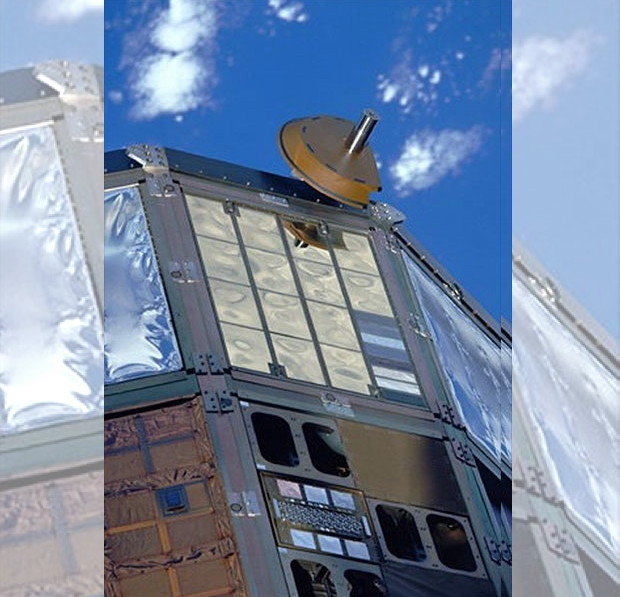Digging for Space History in Surplus Sale of NASA-Flown Gold

A government surplus auction is selling a NASA space artifact that may be worth its weight in gold.
That's because it is gold.
"One lot consisting [of] six 24KT gold plates weighing 6,015.5 grams," the General Services Administration (GSA) listed on its auction website. "These plates were reportedly flown in space for 69 months." [9 Weird Things That Flew on NASA's Space Shuttles]
As of Thursday (Jan. 15), the gold plates had attracted seven bids totaling almost $160,000. The auction ends on Jan. 22.
The GSA listing does not provide many more details about the plates. They are currently the only lot listed under the website's "Shuttle/Hubble" category and originate from NASA's Johnson Space Center in Houston. The GSA auction site offers surplus property from many federal agencies, NASA included.
The "69 months," however, may be a clue as to the plates' spaceflight history.
That specific length of time matches exactly how long NASA's Long Duration Exposure Facility (LDEF) orbited the Earth. The school-bus-size cylindrical satellite circled the planet from 1984 to 1990, collecting data on the long-term effects of space exposure on different types of materials.
Get the Space.com Newsletter
Breaking space news, the latest updates on rocket launches, skywatching events and more!
According to NASA, the information learned from the Long Duration Exposure Facility continues to inform spacecraft design to this day.
Launched on space shuttle Challenger's STS-41C mission on April 6, 1984, LDEF was originally meant to spend less than a year in space. Schedule slips and then the loss of Challenger in January 1986 delayed the satellite's retrieval for 5.7 years.
![According to the General Services Administration (GSA) auction listing, "these [gold] plates were reportedly flown in space for 69 months."](https://cdn.mos.cms.futurecdn.net/Q7ez7DwUUGGszoxEP4GyGV.jpg)
Ultimately, LDEF was returned to Earth by space shuttle Columbia's STS-32 crew on Jan. 12, 1990 — 25 years ago this week.
LDEF's exterior panels did include gold plates. Mounted on the satellite's trailing edge, the high-purity gold was part of the Chemistry of Micrometeoroids Experiment designed to capture cosmic dust residue and orbital debris particles in hypervelocity impacts. After 69 months in space, the gold plates returned with 199 tiny craters.
According to a summary of the experiment, the plates on the facility measured 7.9 inches by 22.4 inches (20 by 57 centimeters) and were about 0.02 inches (0.05 cm) thick. Those dimensions can be used to calculate the volume and, knowing the density of 24-karat gold, the weight of each plate is derived to be about 1,100 grams, or 6,600 grams for six.
The General Service Administration's photos of the plates show that they are riddled with holes, which could account for their lower mass. The holes may be where researchers extracted the craters for post-flight analysis.
Even if NASA were to confirm the plates were from LDEF, their value as an artifact is not likely to greatly affect their sale price. For comparison, tomato seeds that were flown in space onboard LDEF for the same 69 months sell today on eBay for $50 to $100 per package.
At $160,000, the plates may still be a steal. At the current value of gold, the plates are worth about $240,000 for their metal content alone.
Follow collectSPACE.com on Facebook and on Twitter at @collectSPACE. Copyright 2015 collectSPACE.com. All rights reserved.
Join our Space Forums to keep talking space on the latest missions, night sky and more! And if you have a news tip, correction or comment, let us know at: community@space.com.

Robert Pearlman is a space historian, journalist and the founder and editor of collectSPACE.com, a daily news publication and community devoted to space history with a particular focus on how and where space exploration intersects with pop culture. Pearlman is also a contributing writer for Space.com and co-author of "Space Stations: The Art, Science, and Reality of Working in Space” published by Smithsonian Books in 2018.In 2009, he was inducted into the U.S. Space Camp Hall of Fame in Huntsville, Alabama. In 2021, he was honored by the American Astronautical Society with the Ordway Award for Sustained Excellence in Spaceflight History. In 2023, the National Space Club Florida Committee recognized Pearlman with the Kolcum News and Communications Award for excellence in telling the space story along the Space Coast and throughout the world.

